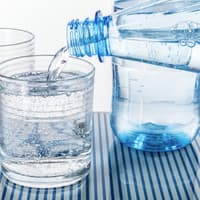
What is lactose intolerance?
It's hard to believe: around three quarters of the world's population suffer from lactose intolerance. In Germany, around 20% cannot tolerate lactose.
Lactose is the technical term for milk sugar. It is contained in dairy products and cannot be absorbed by the intestinal mucosa. However, with the help of an enzyme, the lactose is broken down into individual sugars so that it can enter the bloodstream via the intestinal mucosa. This enzyme is called lactase. It is normally produced by the mucous cells in the small intestine. People with lactose intolerance lack this enzyme and the lactose cannot be processed. As a result, it ends up unchanged in the large intestine, where it feeds bacteria. The waste products that then remain trigger the symptoms.
Lactose is naturally contained in breast milk. Newborn babies can therefore digest it without any problems. After just a few months, however, the enzyme lactase is produced less. If it drops to a certain level, this can lead to lactose intolerance.
Do more people suffer from lactose intolerance today than in the past?
It seems that every second person in Germany has a lactose intolerance (in addition to other intolerances) - is this true or is an intolerance simply "en vogue" at the moment? Presumably more and more people are actually suffering from lactose intolerance because lactose is being added to more and more ready-made products, such as ready-made soups and sauces from a bag. This means that too much lactose is simply being consumed, to which the body reacts. And of course there is more public education these days, whereas in the past you could almost only consult your family doctor. So it's better to cook fresh, then you know what's in it!
Symptoms of lactose intolerance
Typical symptoms of lactose intolerance include flatulence, abdominal pain, diarrhea, bloating, nausea or constipation. It is not considered a disease.
How do I find out if I am lactose intolerant?
If you suspect that you suffer from lactose intolerance, a food diary can initially help. A doctor can use various tests such as a lactose tolerance test, a genetic test or a biopsy of the small intestine to determine whether you are intolerant. A hydrogen breath test or H2 breath test at the doctor's can provide information as to whether the intestinal bacteria produce hydrogen when breaking down the lactose.
Lactose-free foods
If you are lactose intolerant, it is advisable to change your diet. Products with a high lactose content should be removed from the diet. However, this no longer means doing without. There are numerous lactose-free foods and substitute products (lactose-free milk or cream) that are labeled "lactose-free" - people with a lactose intolerance must pay attention to this label. Foods with a maximum of 0.1 grams of lactose per 100 grams are considered "lactose-free". The following foods should be avoided as they have a very high lactose content:
- Milk, condensed milk
- ice cream
- Milk chocolate
- processed cheese
- Skimmed milk powder, whey powder
The following foods contain little lactose and are generally well tolerated by people with lactose intolerance:
- Butter, clarified butter
- Feta cheese
- Camembert, Brie
- mozzarella
- Long-ripened cheeses such as Parmesan
- dark chocolate
How are milk and dairy products made lactose-free?
To produce lactose-free milk, the enzyme lactase is added. This enzyme breaks down the lactose into the simple sugars glucose and galactose. The curious thing is that the two simple sugars taste sweeter than the disaccharide lactose, so that people with a lactose intolerance do not have to miss out on any sweetness in their milk - quite the opposite. Depending on the manufacturer, lactose-free dairy products are made directly from lactose-free milk or the enzyme lactase is added to break down the sugar during processing.
How can the body be supplied with calcium despite lactose intolerance?
As many dairy products contain calcium, people with lactose intolerance lack it. If this is not counteracted, a calcium deficiency can occur, which later favors osteoporosis. However, there are also foods without lactose that are rich in calcium. Many vegetables, such as broccoli, fennel, rocket and kale, contain a lot of it. Almonds and hazelnuts are also good alternatives to dairy products. Also make sure you drink calcium-rich mineral water, which should contain at least 150 mg calcium per liter. A blood test by a doctor can provide information about a possible calcium deficiency in the case of lactose intolerance. This is always advisable before taking food supplements or calcium preparations, as there is often a risk of overdosing. In the event of an undersupply, you should discuss an appropriate intake therapy with your doctor - this is the best solution to ensure that the values are monitored in the long term.
Note: People who are not lactose intolerant can and should use normal dairy products. As a lactose-tolerant person, there is no health benefit at all to using lactose-free products. Lactose-free milk, for example, is therefore not suitable for everyone: It is not healthier, but is designed to give people with an intolerance a better and more varied diet.
You may also be interested in this:
Milk substitutes: The best alternatives to cow's milk
It's all about the milk: Is it healthy or not?
Almond milk: Healthy milk alternative - not just for allergy sufferers
Histamine and fructose intolerance: symptoms, treatment and diet
Wheat intolerance: 5 alternatives for allergy sufferers
Vegan baking & cooking: These plant-based alternatives are available
Date: 19.04.2020
Author: Lena Radke






